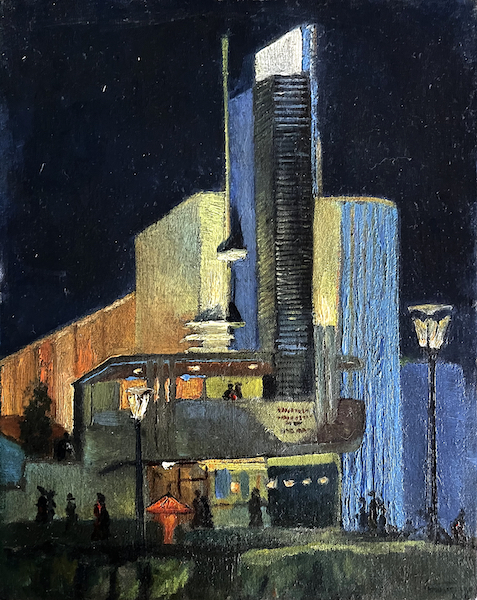Biography
Kásás Gyimesi Ernő Gyimesi was an American painter born in Hungary of Transylvanian Hungarian origin, who also worked as a teacher, writer, journalist, radio host, musician, photographer and film expert. His first teacher, Jenő Gyárfás, directed his preparation for college in Sepsiszentgyörgy. He was an exhibiting artist from 1918. In 1919, he escaped across the front. In 1923, he graduated from the Academy of Fine Arts in Budapest, where he taught Oszkár Glatz and Ágos Benkhard. He was a teaching assistant at the Budapest college for a while, and then attended postgraduate courses in Western Europe.
He had a collective exhibition in 1925 and a studio exhibition in 1926 in Budapest. From 1927 he lived in the USA for a long time. In 1929, he continued his studies at the Chicago Art Institute. He returned home in 1931. In 1933, he obtained an art teacher's certificate in Budapest. He returned to America at the end of 1933.
At the 1933-34 Chicago World's Fair, a What Has the Book Gave to Mankind? He participated with a 12x2 meter fresco plan entitled "Justicia", which ended up in the East Chicago city library, and then commissioned the Indianapolis Art Institute to create the 2.44x3.35 m fresco plan "Justicia", which was installed in the East Chicago courthouse.
Back home in the period between 1925 and 1935, he had his own solo studio exhibitions and participated in group exhibitions at the National Salon. In 1935, he had to give up painting due to a serious spinal injury; He became the director-announcer of the Chicago Air Theater radio show, and also worked as a journalist. In 1936, he returned home to recover. After returning home, he taught at the Institute of Professional Photographers, reported for Cleveland's Szabadság, was editor-in-chief of the Magyar Fotografész monthly, and contributed to the editing and distribution of the Magyar Film weekly as the head of the publishing office. In 1938, he created a map for the Hungarian Film News, showing the location and number of Hungarians in the states of the USA.
Between 1938 and 1944, he was a senior employee of Képes Magazin. In 1939, the plan of the Hungarian Photographic Museum was first published in the newspaper. During the Vienna decisions, he reported on Beregszász and Transylvania. In 1956, he was an air defense commissioner and performed good service activities.
He defected and already in December 1956 helped the Hungarian refugees through his former acquaintances living in the USA. He moved to Boston, and soon had an exhibition at the Doll and Richards Newbury Gallery during the 1957/58 New Year. He taught at Farleigh Dickinson University and then settled in New York. Between 1964 and 1994, he was the founder and executive president of the World Association of Hungarian Artists Abroad. Between 1969 and 1988, he was the chairman of the fine arts department of the Árpád Academy; For 20 years, he was the main director of the exhibitions of the Árpád Academy.
He was one of the first to establish the Hungarian House in New York, and in 1971 he organized the first Hungarian Book and Press Day here. In 1970, two of his paintings were presented at the Grand Palais 1970 Le Salon exhibition in Paris. In 1978 he traveled home to Transylvania; He visited György Sepsiszent and there an independent exhibition was organized in his honor at the Székely National Museum. By 1979, he had painted 3,500 pictures. The Hungarian National Gallery keeps 3 works, the Székely National Museum 20 works. From 1990, he was the vice president of the Fészek Klub.

